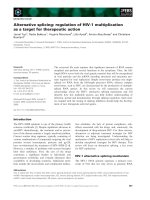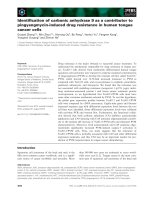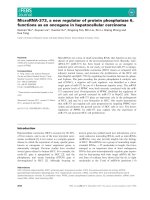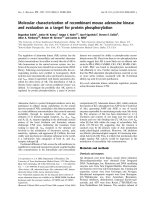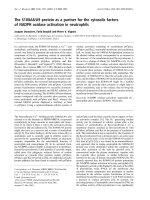Expression of miR - 122 plasma as a biomarker for hepatocellular carcinoma
Bạn đang xem bản rút gọn của tài liệu. Xem và tải ngay bản đầy đủ của tài liệu tại đây (230.42 KB, 6 trang )
Journal of military pharmaco-medicine n09-2018
EXPRESSION OF miR-122 PLASMA AS A BIOMARKER FOR
HEPATOCELLULAR CARCINOMA
Dang Chieu Dương1; Phan Quoc Hoan2; Le Huu Song2
Nguyen Linh Toan3; Ngo Tat Trung2
SUMMARY
Objectives: MicroRNAs participate in cell proliferation, apoptosis and transformation.
However, the use of microRNAs-122 in combination with alpha-fetoprotein has not been
evaluated. In this study, we aim to evaluate the expression of microRNAs-122 plasma, and
combination of microRNAs-122 with alpha-fetoprotein to diagnosis of hepatocellular carcinoma.
Subjects and methods: Real-time PCR was employed to measure microRNAs-122 expression
levels on 250 plasma samples of 101 patients with hepatitis B virus-related hepatocellular
carcinoma, 46 chronic hepatitis B patients and 103 healthy controls. Results: The relative
expression levels of microRNAs-122 in hepatitis B virus-related hepatocellular carcinoma
patients were higher than chronic hepatitis B and healthy controls (p < 0.001). The individual
microRNAs-122 acquired high diagnostic accuracy for hepatocellular carcinoma surveillance
(hepatocellular carcinoma vs. chronic hepatitis B, AUC = 0.910; hepatocellular carcinoma vs.
healthy controls, AUC = 0.989). When alpha-fetoprotein levels were lower than 20 ng/mL,
microRNAs-122 still preserves accuracy to distinguish hepatocellular carcinoma from other
groups (chronic hepatitis B, AUC = 0.915; healthy controls, AUC = 0.991). When microRNAs122 were used in combination with alpha-fetoprotein levels, the diagnostic performance was
significantly improved in discriminating hepatocellular carcinoma from group chronic hepatitis B
(AUC = 0.914). Conclusions: MicroRNAs-122 is a potential biomarker to improve diagnostic in
hepatitis B virus-related hepatocellular carcinoma patients, especially in patients with
hepatocellular carcinoma with normal alpha-fetoprotein level.
* Keywords: Hepatocellular carcinoma; MicroRNAs-122; Alpha-fetoprotein.
INTRODUCTION
Liver cancer is currently the second
most common cause of cancer-related
death worldwide, and hepatocellular
carcinoma (HCC) accounts for more than
90% of liver cancers [1]. One of the
reasons for the high mortality in HCC is
that the tumors are frequently detected
at a stage when curative resection is no
longer feasible because of intrahepatic
and extrahepatic metastases. Today, the
diagnosis of HCC relies on the finding of
a liver mass in radiology imaging studies
including ultrasonography, computed
tomography (CT), and/or magnetic resonance
imaging (MRI) [2]. However, the diagnosis
of small lesions is relatively inaccurate.
One of the common approaches used
1. Viettiep Hospital
2. 108 Military Central Hospital
3. Vietnam Military Medical University
Corresponding author: Dang Chieu Duong ()
Date received: 01/10/2018
Date accepted: 14/11/2018
95
Journal of military pharmaco-medicine n09-2018
for screening HCC in a high riskpopulation is serum tumor markers such
as alpha-fetoprotein (AFP) and Desgamma-carboxy prothrombin (DCP). The
performance of the currently used serum
protein biomarkers for routine surveillance
of HCC is unsatisfied [3]. Therefore, new
biomarkers with better accuracy or with
capabilities to complement for hepatic
imaging are in need to improve the
surveillance of HCC.
MicroRNA (miR) is a small noncoding
RNA gene product known to posttranscriptionally modulate gene expression
by negatively regulating the stability or
translational efficiency of its target
mRNAs. MiRs control a wide array of
biological processes, such as cell
differentiation, proliferation, and apoptosis
[4]. Expressions of miRs have been
widely reported in human cancers with
both up and down-regulation detected in
neoplastic cells compared with their
normal counterparts. Several recent
studies reported that miRs are stably
detectable in plasma and serum. The
finding also raised the possibility that
assaying miRs in plasma or serum may
serve as a novel approach for bloodbased detection of human cancers [5]. In
this study, we focused on miR-122, which
is one of the first miRs detected
abundantly in HCC. We aim to: Evaluate
the expression of miR-122 plasma, and
combination of miR-122 with AFP to
diagnosis of HCC.
SUBJECTS AND METHODS
1. Subjects.
Patients and sample: Plasma samples
from 101 patients with hepatitis B virus
96
(HBV)-related HCC, 46 chronic hepatitis
B (CHB), and 103 healthy control (HC)
were collected for this study between
2014 and 2017. Biopsies were taken in all
patients with HCC and CHB. HCC and
CHB were confirmed histologically in the
groups. Blood samples were obtained
from all patients and healthy controls,
plasma samples were immediately
separated from blood cells and were stored
at -800C until use. MiRNA extraction and
cDNA synthesis: Total RNA, including
miRNA fractions was isolated from 200 µL
serum
with
TRIzol
reagent
and
reconstituted in 50 µL water treated with
diethylpyrocarbonate (DEPC). The quality
of total RNA preparations was assessed
by NanoDrop spectrometer at 260 and
280 nm (A260/280). Approximately 300 ng
of total RNA were used for reverse
transcription (RT) by RevertAid First
Strand cDNA Synthesis Kit following the
manufacturer's instruction. Primers used
for cDNA synthesis were designed
according to stem-loop. Quantification of
miR-122 by real-time PCR: After reverse
transcription, cDNA was reconstituted in
100 µL 25 mM-Tris-HCl pH 8.0. The realtime PCR (qPCR) reaction mixtures
consisted of 10 µL of 2x Sybr-Green I
master mix, 5 µL of cDNA preparation,
5 pmoL of miR-122 universal reverse
primer GTGCAGGGTCCGAGGT and
5 pmoL of forward primer specific for
miR-122. The qPCR reaction was performed
using the Stratagene M3000p device
with a pre-incubation step at 500C for
15 minutes, initial denaturation at 950C for
5 minutes, followed by 45 cycles of 950C
for 15 sec and 600C for 60 seconds.
The RT-PCR reactions were finalized by
Journal of military pharmaco-medicine n09-2018
amplicon melting dissociation. The cycle of
threshold (Ct) values were recorded and
analyzed according to the comparative Ct
method, in which the Ct value of miR-16
was used as normalization factor [6].
Statistical analysis: The HCC staging
was performed according to the Barcelona
clinic liver cancer (BCLC) staging system.
Data ware expressed as mean ± SD.
Differences between groups were
assessed by the t-test, or the MannWhitney U test, p value < 0.05 denoted
the presence of a statistically significant
difference. The diagnostic value for
differentiating between HCC patients and
the control was assessed by calculating
the area under the receiver operator
characteristic (ROC) curve (AUC). All
statistical analyses were performed using
SPSS (version 21.0).
RESULTS
The main clinical and demographic characteristics such as age, gender, viral loads
and the tumour marker AFP for HCC patients, CHB patients, and 103 healthy controls
are summarized in table 1.
Table 1: Clinical characteristics of the studied patients.
HCC
CHB
HC
(n = 101)
(n = 46)
(n = 103)
55.6 ± 12.34
41.43 ± 11.54
24 ± 6.42
Gender (M: %)
93.1
95.7
76.7
AFP (ng/mL)*
339.29 ± 574.02
43.81 ± 142.97
NA
5.01 ± 1.52
6.63 ± 1.97
NA
65/36
NA
NA
Maximum tumor size (cm)
7.78 ± 3.41
NA
NA
Vascular invasion (yes/no)
23/78
NA
NA
25/46/10
NA
NA
16/50/34/1
NA
NA
Characteristics
Age (years)
HBV-DNA (log)*
Tumor number (solitary/multiple)
Tumor differentiation
(high/intermediate/low)
BCLC staging (A/B/C/D)
(*: p < 0.05 for comparison HCC vs. CHB; NA: Not applicable)
Levels of HBV loads were significantly higher in CHB compared to HCC group
(p < 0.05). As expected, the levels of the tumour marker AFP were observed
significantly higher in HCC patients compared to CHB patients (p < 0.05).
97
Journal of military pharmaco-medicine n09-2018
Figure 1: Differential expression miR-122 levels in different groups.
The plasma miR-122 expression in patients with HCC was significantly higher than
in patients with CHB and HC (p < 0.001, p < 0.001, respectively).
Figure 2: Diagnostic performance of miR-122 and miR-122 in combination with AFP in
differentiating HCC from other groups.
(A: HCC vs. CHB; B: HCC [AFP ≤ 20 ng/mL] vs. CHB; C: HCC vs. HC and D: HCC
[AFP ≤ 20 ng/mL] vs. HC)
98
Journal of military pharmaco-medicine n09-2018
Table 2: Diagnostic performance of miR-122 and miR-122 in combination with AFP
in differentiating HCC against control subjects.
AUC
Variable(s)
HCC vs. CHB
HCC vs. HC
HCC (AFP ≤ 20 ng/mL)
vs. CHB
HCC (AFP ≤ 20ng/mL)
vs. HC
AFP*
0.758
NA
NA
NA
miR-122*
0.910
0.989
0.915
0.991
AFP + miR-122**
0.914
NA
NA
NA
(*: p < 0.05 for comparison AFP vs. miR-122; **: p < 0.05 for comparison AFP vs.
miR-122+AFP; A: Not applicable)
Diagnostic performance of miR-122
was significantly higher than AFP levels in
differentiating HCC from CHB (p < 0.05).
When miR-122 is combined with AFP
levels to form the so-called (miR-122 + AFP)
panel under the logistic regression model,
the diagnostic performance in discriminating
HCC from CHB obtained higher accuracy
(AUC = 0.914, p < 0.05). When the AFP
levels were lower than 20 ng/mL, miR-122
still preserved its diagnostic accuracy to
distinguish HCC from other groups
including CHB patients (AUC = 0.915),
with either HC (AUC = 0.991).
DISCUSSION
Cancer-specific alterations of miRs
expression are common in various
cancers and act as critical roles in cancer
progression. More and more evidence
indicated that circulating plasma miRs
served as promising biomarker for
diagnosing and monitoring treatment
response. Circulating miRs have been
found to be stable in serum and plasma,
suggesting its potential ability to be
diagnostic biomarkers. Currently, AFP is
often criticized for its high false positivity
in distinguishing HCC with other liver
diseases. In addition, it is estimated that
30 - 40% of all HCC patients are of AFPnegative status, making it difficult to
diagnose and assess treatment response
[7]. Thus, identifying a new biomarker that
could complement AFP is of great
importance. For now, several miRs have
been identified as novel biomarkers for
HCC [8].
In this study, we conducted analysis to
evaluate whether plasma miR-122 had
the potential ability to be a new biomarker
for detecting HCC. In pilot group, we
assessed the expression of miR-122 on
250 plasma samples of 101 patients with
HBV-related HCC, 46 chronic hepatitis B
patients and 103 HC. The present study
demonstrated that plasma miR-122
expression in patients with HCC was
significantly higher than in patients with
CHB and HC (p < 0.001, p < 0.001,
respectively). ROC analyses for the
diagnostic power of plasma miR-122
yielded an AUC of 0.910 in differentiating
patients with HCC from those with CHB,
AUC of 0.989 in differentiating patients
with HCC from HC.
These results suggest that plasma
miR-122 is a valuable biomarker for HCC.
Furthermore, the superiority of the
99
Journal of military pharmaco-medicine n09-2018
differentiating power of a single
measurement of plasma miR-122 compared
with AFP was statistically confirmed, and
the differentiating power of the combination
of plasma miR-122 and AFP was
significantly stronger than AFP alone,
suggesting that measurement of both
plasma miR-122 and AFP has a better
differentiating power than plasma miR122 and AFP alone. Furthermore, plasma
miR-122 level was significantly elevated
even in patients with HCC who have AFP
levels under 20 ng/mL. When the AFP
levels were lower than 20 ng/mL, miR122 still preserved its diagnostic accuracy
to distinguish HCC from other groups
including CHB patients (AUC = 0.915),
with either HC (AUC = 0.991). Whatever
the reason, that differentiating power of
plasma miR-122 was significantly superior
to that of AFP, we suggested that plasma
miR-122 is a useful diagnostic marker for
HCC. At the same time, we must keep in
mind that, as even patients with advanced
HCC were included in the present study,
the enrollment of the patients was not
designed for the examination of
diagnostic markers, suggesting the
possibility that the aforementioned
sensitivity and specificity might be overestimated. In addition, we did not examine
plasma miR-122 level in cirrhotic patients
who also have possibility for developing
HCC in the present study. We should
investigate
whether
the
miR-122
measurement is useful in differentiating
HCC patients from cirrhotic patients in the
future. Furthermore, large-scale cohorts
and strict study design are needed
to further confirm the diagnostic role of
miR-122.
100
CONCLUSIONS
Our findings suggest that plasma miR122 levels may help enhance the
diagnosis of HCC, especially for AFPnegative HCC.
REFERENCES
1. Omata M, Cheng A.L, Kokudo N et al.
Asia-Pacific clinical practice guidelines on the
management of HCC: A 2017 update. Hepatol
Int. 2017, 11 (4), pp.317-370.
2. Yu W.B, Rao A, Vu V et al.
Management of centrally located HCC:
Update 2016. World J Hepatol. 2017, 9 (13),
pp.627-634.
3. Toyoda H, Kumada T, Tada T et al.
Tumor markers for HCC: Simple and significant
predictors of outcome in patients with HCC.
Liver Cancer. 2015, 4 (2), pp.126-136.
4. Tsuchiya N, Sawada Y, Endo I et al.
Biomarkers for the early diagnosis of HCC.
World J Gastroenterol. 2015, 21 (37),
pp.10573-10583.
5. Hayes C.N, Chayama K. Micro-RNAs as
biomarkers for liver disease and HCC. J Mol
Sci. 2016, 17 (3), p.280.
6. Livak K.J, Schmittgen T.D. Analysis of
relative gene expression data using real-time
quantitative PCR and the 2(-delta delta C(T))
method. Methods. 2001, 25 (4), pp.402-408.
7. Bruix J, Sherman M. American
Association for the study of liver, management
of HCC: An update. Hepatology. 2011, 53 (3),
pp.1020-1022.
8. Ding Y, Yan J.L, Fang A.N et al.
Circulating miRNAs as novel diagnostic
biomarkers in HCC detection: A meta-analysis
based on 24 articles. Oncotarget. 2017, 8 (39),
pp.66402-66413.
9. This research is funded by Vietnam
National Foundation for Science and
Technology
Development
(NAFOSTED)
under grant number; 106-Ys.02-2016.20.


